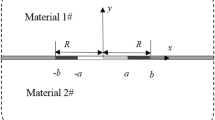Abstract
The heat dipole consists of a heat source and a heat sink. The problem of an interfacial crack of a composite containing a circular inclusion under a heat dipole is investigated by using the analytical extension technique, the generalized Liouville theorem, and the Muskhelishvili boundary value theory. Temperature and stress fields are formulated. The effects of the temperature field and the inhomogeneity on the interfacial fracture are analyzed. As a numerical illustration, the thermal stress intensity factors of the interfacial crack are presented for various material combinations and different positions of the heat dipole. The characteristics of the interfacial crack depend on the elasticity, the thermal property of the composite, and the condition of the dipole.
Similar content being viewed by others
Abbreviations
- R :
-
inclusion radius
- L′ :
-
interfacial crack arc
- L :
-
interface arc
- S +, S − :
-
inclusion domain and matrix domain
- I, II:
-
material numbers for inclusion and matrix
- μ j , κ j :
-
elasticity constants of the jth material
- ρ :
-
polar radius of heat dipole center location
- θ :
-
polar angle of heat dipole center location
- r :
-
half span length of heat dipole
- z 1, z 2 :
-
coordinates of heat source and heat sink
- ϕ :
-
angle between the span line and the x-axis
- α :
-
half of the central angle of the crack arc
- T(·):
-
temperature field function
- Re(·):
-
real part of a complex variable or a complex function
- i:
-
imaginary unit
- \( \overline {( \cdot )} \) :
-
conjugate value of a complex parameter
- g(·):
-
the real part of its differential is the complex function for temperature
- q :
-
heat flux
- Q :
-
total heat transfer rate
- κ t :
-
the coefficient of heat conductivity
- σ :
-
normal stress
- τ :
-
shear stress
- ϕ(·), ψ(·):
-
complex potential functions for stress
- Φ(·), Ψ(·):
-
differential function of complex potential for stress
- β :
-
heat expansion coefficient
- u, υ :
-
displacements
- e, f, K, W, σ, S, J, N, O :
-
constants
- K j , K jl :
-
stress intensity factors of crack tip
- Y (·):
-
Plemelj function
- ω(·):
-
transform function
References
Mindlin, R. D. and Cheng, D. H. Thermoelastic stress in the semi-infinite solid. Journal of Applied Physics 21(9), 931–933 (1950)
Zhu, Z. H. and Muguid, S. A. On the thermoelastic stresses of multiple interacting inhomogeneities. International Journal of Solids and Structures 37(16), 2313–2330 (2000)
Muskhelishvili, N. I. Some Basic Problems of the Mathematical Theory of Elasticity, Noordhoff, Leyden (1975)
Chao, C. K. and Chang, R. C. Thermal interface crack problems in dissimilar anisotropic media. Journal of Applied Physics 72(7), 2598–2604 (1992)
Qin, Q. H. Thermoelectroelastic solution for elliptic inclusions and application to crack-inclusion problems. Applied Mathematical Modelling 25(1), 1–23 (2000)
Xiao, W. S. and Wei, G. Interaction between screw dislocation and circular crack under uniform heat flux (in Chinese). Journal of Mechanical Strength 29(5), 779–783 (2007)
Pham, C. V., Hasebe, N., Wang, X. F., and Saito, T. Interaction between a cracked hole and a line crack under uniform heat flux. International Journal of Fracture 13(4), 367–384 (2005)
Hasebe, N., Wang, X. F., Saito, T., and Sheng, W. Interaction between a rigid inclusion and a line crack under uniform heat flux. International Journal of Solids and Structures 44(7–8), 2426–2441 (2007)
Chao, C. K. and Shen, M. H. On bonded circular inclusions in plane thermoelasticity. Journal of Applied Mechanics 64(4), 1000–1004 (1997)
Chao, C. K. and Tan, C. J. On the general solutions for annular problems with a point heat source. Journal of Applied Mechanics 67(3), 511–518 (2000)
Rahman, M. The axisymmetric contact problem of thermoelasticity in the presence of an internal heat source. International Journal of Engineering Science 41(16), 1899–1911 (2003)
Chao, C. K. and Chen, F. M. Thermal stresses in an isotropic trimaterial interacted with a pair of point heat source and heat sink. International Journal of Solids and Structures 41(22–23), 6233–6247 (2004)
Hasebe, N. and Wang, X. F. Complex variable method for thermal stress problem. Journal of Thermal Stresses 28(6–7), 595–648 (2005)
Sih, G. C., Raris, P. C., and Erdogan, F. Crack-tip stress factors for plane extension and plane bending problem. Journal of Applied Mechanics 29(1), 306–312 (1962)
Author information
Authors and Affiliations
Corresponding author
Additional information
Communicated by Xing-ming GUO
Rights and permissions
About this article
Cite this article
Xiao, Ws., Xie, C. & Liu, Yw. Interaction between heat dipole and circular interfacial crack. Appl. Math. Mech.-Engl. Ed. 30, 1221–1232 (2009). https://doi.org/10.1007/s10483-009-1002-x
Received:
Revised:
Published:
Issue Date:
DOI: https://doi.org/10.1007/s10483-009-1002-x




